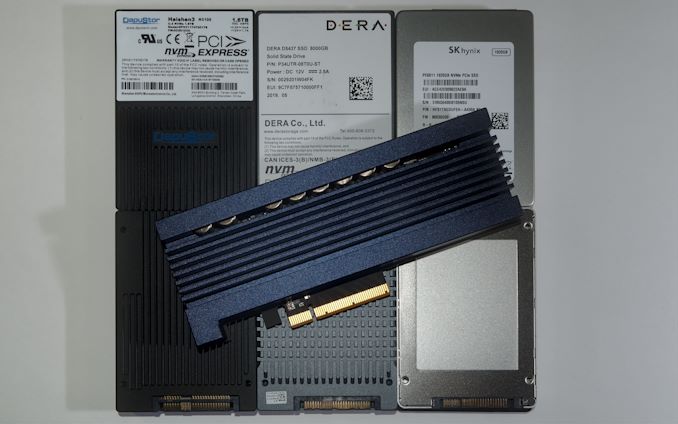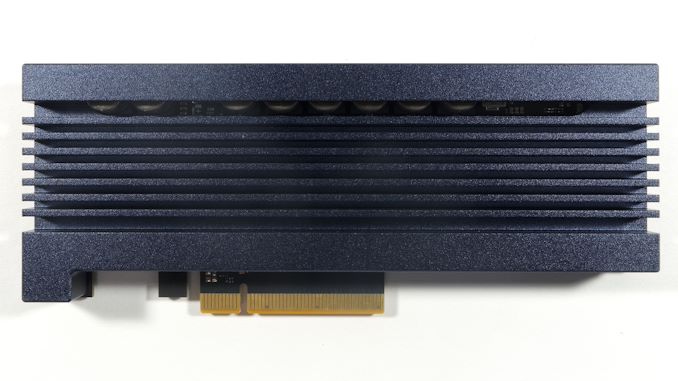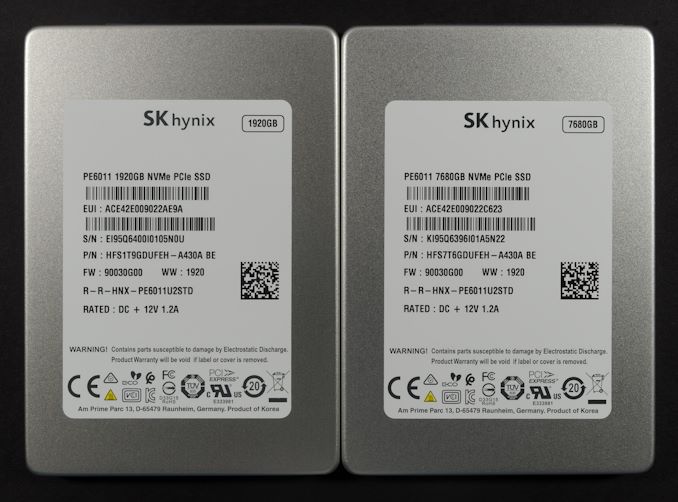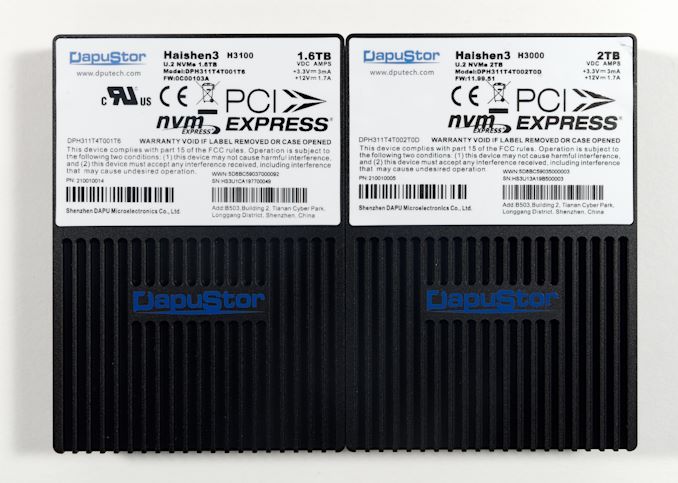Enterprise NVMe Round-Up 2: SK Hynix, Samsung, DapuStor and DERA
by Billy Tallis on February 14, 2020 11:15 AM EST
Last fall, several enterprise SSD vendors reached out to us around the same time, offering review samples of their latest and greatest. We put together an updated test suite for enterprise and datacenter SSDs and spent more than a month hammering the drives. Our review of two SATA drives was published first, but this review of 9 NVMe drives is what we've really been looking forward to. These multi-TB drives show just how far NVMe can go beyond the limits of SATA and SAS SSDs.
Two of the products we're looking at today come from familiar manufacturers. Samsung is the dominant player in the SSD market, shipping more drives than the next three companies combined. We have their PM1725a in house: an older flagship model, but still the fastest we've ever tested with almost twice the random read performance of an Intel Optane SSD. SK Hynix sent over their PE6011, a low-power entry-level datacenter U.2 drive that is part of their strategy to reestablish a foothold in market segments where they have faltered in recent years.
We also have two new brands featured in one of our reviews for the first time. DapuStor and DERA are two Chinese drive manufacturers that have been around for a few years but have until recently been focusing on their domestic market. DERA's strategy is more centered around developing home-grown technology to compete with foreign suppliers by designing their own SSD controller. DapuStor worked with familiar names like Marvell and Kioxia/Toshiba to create datacenter SSDs focused on efficiency, while also pursuing a long-term roadmap toward advanced in-house tech.
Nine new drives adding up to 40TB of high-end storage might seem like a lot, but it's barely enough to to cover the breadth of the enterprise SSD market. No two of these models are in direct competition. Enterprise SSD product segments can be defined in terms of form factor, write endurance, capacity and performance. Different use cases will call for a different kind of drive, and there's no one size fits all solution.
| Reviewed Models Overview (Drives Tested in Bold) |
|||||||
| Model | Interface | Form Factor | Capacities | Memory | Write Endurance (DWPD) |
||
| DapuStor Haishen3 H3000 |
PCIe 3.0 x4 | 2.5" 15mm U.2 | 1 TB 2 TB 4 TB 8 TB |
96L 3D TLC | 1 DWPD | ||
| DapuStor Haishen3 H3100 |
PCIe 3.0 x4 | 2.5" 15mm U.2 | 800 GB 1.6 TB 3.2 TB 6.4 TB |
96L 3D TLC | 3 DWPD | ||
| DERA D5437 |
PCIe 3.0 x4 | 2.5" 15mm U.2 | 2 TB 4 TB 8 TB |
64L 3D TLC | 1 DWPD | ||
| DERA D5457 |
PCIe 3.0 x4 | 2.5" 15mm U.2 | 1.6 TB 3.2 TB 6.4 TB |
64L 3D TLC | 3 DWPD | ||
| SK Hynix PE6011 |
PCIe 3.0 x4 | 2.5" 7mm U.2 | 960 GB 1.92 TB 3.84 TB 7.68 TB |
72L 3D TLC | 1 DWPD | ||
| Samsung PM1725a |
PCIe 3.0 x8 | HHHL AIC | 1.6 TB 3.2 TB 6.4 TB |
48L 3D TLC | 5 DWPD | ||
| Previously Reviewed by AnandTech: | |||||||
| Micron 5100 MAX |
SATA | 2.5" 7mm | 240 GB 480 GB 960 GB 1.92 TB |
32L 3D TLC | 5 DWPD | ||
| Samsung 883 DCT |
SATA | 2.5" 7mm | 240 GB 480 GB 960 GB 1.92 TB 3.84 TB |
64L 3D TLC | 0.8 DWPD | ||
| Samsung 983 DCT |
PCIe 3.0 x4 | 2.5" 7mm U.2 | 960 GB 1.92 TB |
64L 3D TLC | 0.8 DWPD | ||
| Intel DC P4510 |
PCIe 3.0 x4 | 2.5" 15mm U.2 | 1 TB 2 TB 4 TB 8 TB |
64L 3D TLC | 0.7–1.1 DWPD | ||
| Intel Optane DC P4800X |
PCIe 3.0 x4 | HHHL AIC | 375 GB 750 GB 1.5 TB |
3D XPoint | 60 DWPD | ||
| Memblaze PBlaze5 C916 |
PCIe 3.0 x8 | HHHL AIC | 3.2 TB 6.4 TB |
64L 3D TLC | 3 DWPD | ||
| Note: Tested capacities are shown in bold | |||||||
To provide some more meaningful comparisons, we've retested and included several other enterprise SSDs from previous reviews.














33 Comments
View All Comments
Billy Tallis - Friday, February 14, 2020 - link
Me, too. It's a pity that we'll probably never see the Micron X100 out in the open, but I'm hopeful about Intel Alder Stream.I do find it interesting how Optane doesn't even come close to offering the highest throughput (sequential reads or writes or random reads), but its performance varies so little with workload that it excels in all the corner cases where flash fails.
curufinwewins - Friday, February 14, 2020 - link
Absolutely. It's so completely counter to the reliance on massive parallelization and over provisioning/cache to hide the inherent weaknesses of flash that I just can't help but being excited about what is actually possible with it.extide - Friday, February 14, 2020 - link
And honestly most of those corner cases are far more important/common in real world workloads. Mixed read/write, and low QD random reads are hugely important and in those two metrics it annihilates the rest of the drives.PandaBear - Friday, February 14, 2020 - link
Throughput has alot to do with how many dies you can run in parallel, and since optane has a much lower density (therefore more expensive and lower capacity), they don't have as many dies on the same drive, and that's why peak throughput will not be similar to the monsters out there with 128-256 dies on the same drive. They make it back in other spec of course, and therefore demand a premium for that.swarm3d - Monday, February 17, 2020 - link
Sequential read/write speed is highly overrated. Random reads and writes make up the majority of a typical workload for most people, though sequential reads will benefit things like game load times and possibly video edit rendering (if processing isn't a bottleneck, which is usually is).Put another way, if sequential read/write speed was important, tape drives would probably be the dominant storage tech by now.
PandaBear - Friday, February 14, 2020 - link
Some info from the industry is that AWS is internally designing their own SSD and the 2nd generation is based off the same Zao architecture and 96 layer Kioxia NAND that DapuStor makes. For this reason it is likely that it will be a baseline benchmark for most ESSD out there (i.e. you have to be better than that or we can make it cheaper). Samsung is always going to be the powerhouse because they can afford to make a massive controller with so much more circuits that would be too expensive for others. SK Hynix's strategy is to make an expensive controller so they can make money back from the NAND. Dera and DapuStor will likely only focus in China and Africa like their Huawei pal. Micron has a bad reputation as an ESSD vendor and they ended up firing their whole Tidal System team after Sanjay joined, and Sanjay pouched a bunch of WD/SanDisk people to rebuild the whole group from ground up.eek2121 - Friday, February 14, 2020 - link
I wish higher capacity SSDs were available for consumers. Yes, there are only a small minority of us, but I would gladly purchase a high performance 16TB SSD.I suspect the m.2 form factor is imperfect for high density solid state storage, however. Between heat issues (my 2 TB 970 EVO has hit 88C in rare cases...with a heatsink. My other 960 EVO without a heatsink has gotten even hotter.) and the lack of physical space for NAND, we will likely have to come up with another solution if capacities are to go up.
Billy Tallis - Friday, February 14, 2020 - link
Going beyond M.2 for the sake of higher capacity consumer storage would only happen if it becomes significantly cheaper to make SSDs with more than 64 NAND dies, which is currently 4TB for TLC. Per-die capacity is going up slowly over time, but fast enough to keep up with consumer storage needs. In order for the consumer market to shift toward drives with way more than 64 NAND dies, we would need to see per-wafer costs drop dramatically, and that's just not going to happen.Hul8 - Saturday, February 15, 2020 - link
I think the number of consumers both interested in 6GB+ *and* able to afford them are so few, SSD manufacturers figure they can just go buy enterprise stuff.Hul8 - Saturday, February 15, 2020 - link
*6TB+, obviously... :-D